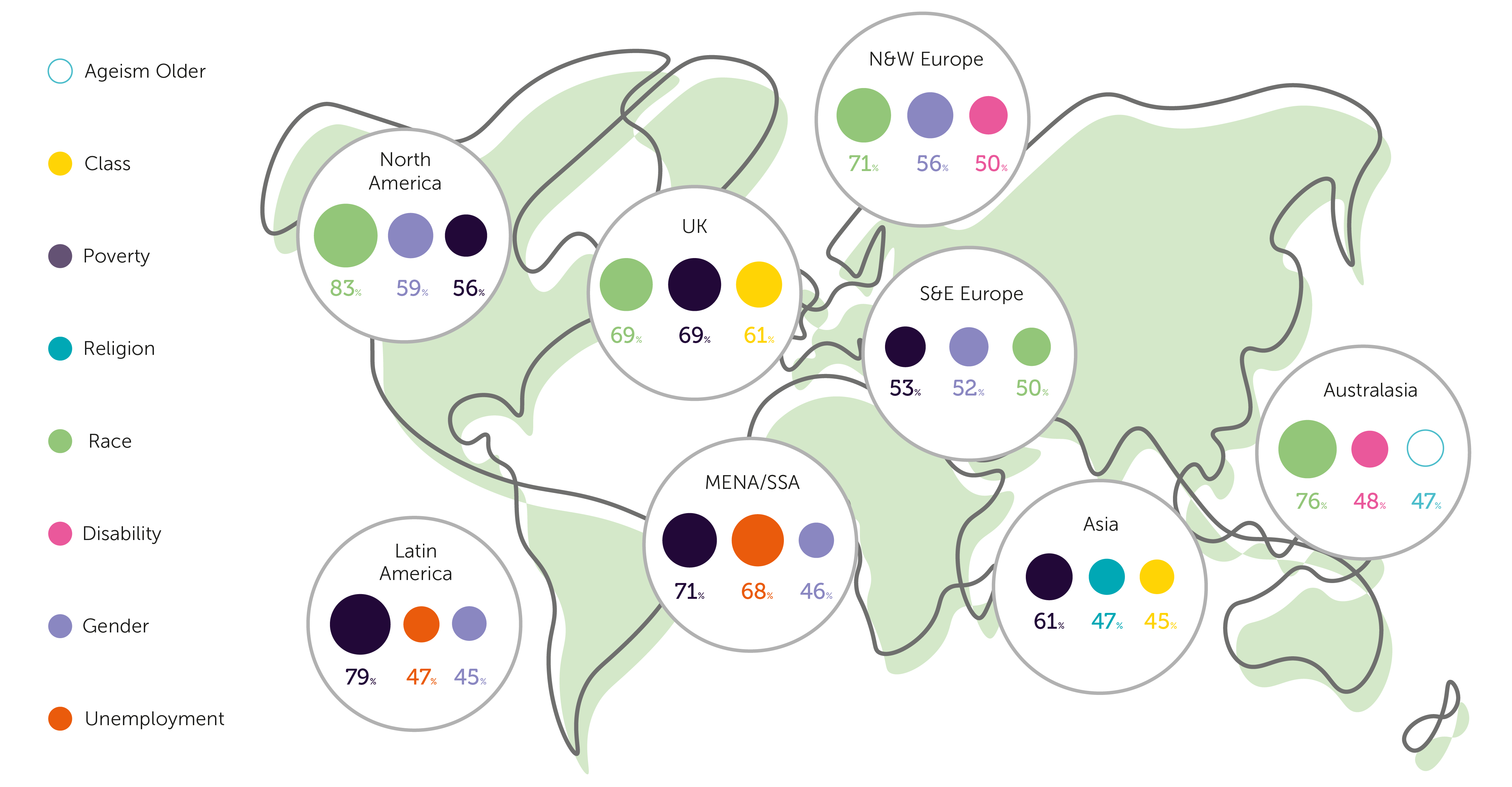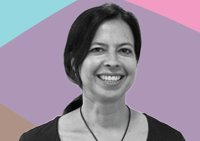As inclusivity has grown and multiculturalism has expanded, people have been able to defy their circumstances and navigate their escape from poverty more frequently, however, the socioeconomic landscape and stark inequalities of today are still resonant.
Poverty is also the insurmountable opponent which levels all nations – very few people are completely immune to it and most people, directly or indirectly, have some experience of it.
- What inclusivity means
- Through the barricades: establishing barriers to inclusivity
- Discrimination dialogue: race not won
- Return to gender: a path well-travelled
- Breaking good: taking down the walls of academia
- Academic culture: playing catch-up
- Driving inclusivity: responsibilities within academic research
- Road ahead: the future is open
- Final analysis
Top societal issues
Question: Thinking about the country which you live in, what do you think are the biggest barriers to living in a fair and inclusive society for everyone?

| Issue | % |
|---|---|
| Poverty | 60% |
| Racial / ethnic discrimination | 58% |
| Gender discrimination | 49% |
| Class discrimination | 41% |
| Government policy | 38% |
| There were a multitude of additional factors also cited: unemployment (35%), discrimination to the disabled (34%), religious discrimination (31%), access to medical care (27%), discrimination because of sexuality (25%), age discrimination towards older people (25%), discrimination towards people with learning needs (25%) lack of access digitally (19%), no safe or sanitary housing (12%), age discrimination towards younger people (11%) and conflict/war zones (11%) | |
Top three societal issues by region

| Region | 1 | 2 | 3 |
|---|---|---|---|
| Asia | Poverty 61% | Religion 47% | Class 45% |
| Australasia | Race 76% | Disability 48% | Ageism against older gen. 47% |
| MENA/SSA | Poverty 71% | Unemployment 68% | Gender 46% |
| N Europe | Race 71% | Gender 60% | Disability 50% |
| N America | Race 83% | Gender 59% | Poverty 55% |
| S Europe | Poverty 53% | Gender 51% | Race 50% |
| Latin America | Poverty 79% | Unemployment 47% | Gender 25% |
| United Kingdom | Race 69% | Poverty 69% | Class 61% |
Poor performance
Poverty was cited by 60% of respondents as a major issue, although the general public’s view differs – particularly in the UK – where it wasn’t seen as a significant problem. This perhaps chimes with the era of poverty being a ‘hidden’ issue or one that is not fully appreciated in all its complexity.
While poverty was recognised across all regions as a key issue, some regarded it as an area of much greater importance than others. Latin America topped the table with 79%, Middle East and North African countries/Sub-Saharan Africa recorded 71%, followed by the UK on 69% and Asia on 61%. Meanwhile, north and western European countries (excluding UK) had the lowest figures, but still returned 40%.
Class was rated as the fourth biggest factor, meaning those in poverty are perceived to be in a lower ranking class in broader society. They are also considered to have the biggest struggles and, therefore, rely on those with more to help break down the barriers to inclusivity.
60% of respondents cited poverty as a major issue.
Harsh truth
Poverty remains prevalent in societies throughout the world. The economic circumstances into which you are born will often determine your opportunities, or lack thereof, throughout your lifespan.
The UN often refers to poverty as a ‘vicious circle’, made up of a range of factors which are interlinked. A deprivation of resources, capability and opportunities makes it difficult for anyone in poverty to satisfy the most basic human needs or, critically, to enjoy human rights. It’s a familiar problem, repeated in every city and town throughout the world.
The COVID-19 pandemic has been a bleak reminder of the chasmic divide between socioeconomic groups and how the threat of disease, financial status and occupation are inseparably linked. During this period, families who typically struggle with food provision, internet connectivity and poor housing are facing even greater adversity.
Expert analysis
Dr Emma Stone of the Good Things Foundation talks about poverty & digital exclusion
In the UK, we know that digital exclusion and poverty correlate closely. Drawing on Ofcom's annual surveys of ‘Adult Media Use and Attitudes’, the Office for National Statistics data on ‘Internet Access in Great Britain’ and the Lloyds Consumer Digital Index – we know that nearly half the 'offline' population is under 60, and that you are much more likely to be digitally excluded if you have low educational attainment, live in a low income household and/or have a disability or health condition.
In the UK, 1.9 million households lack internet access, while 11.7 million people lack all the essential digital skills needed for life today and around 14 million people live in poverty.
Covid-19 has exposed the links between poverty, educational disadvantage and digital exclusion even further. Since lockdown, we have been campaigning tirelessly to get support for DevicesDotNow a UK initiative to get devices, connectivity and digital skills support out to individuals and families who urgently need it.
When schools, community centres and libraries shut, many children and adults were locked out of access to essential support, contact with friends and family and the ability to work or learn from home.
When we've been able to make this support available, the impact on people's lives has been transformative – opening up access to learning and working, health information and welfare benefits and, above all, contact with families, friends and communities.
We know that this isn't going to go away. Covid-19 has been a wake-up call to the scale of digital exclusion – how it is a consequence of, and a contributing factor to, both poverty and educational disadvantages.
What's more, unlike basic literacy or numeracy, the goalposts keep changing as digital technology keeps evolving. The pandemic has seen more people go online than ever before – and it has accelerated the channel shift towards digital in every part of our lives. Now, more than ever, our governments need to prioritise digital inclusion as a social and economic, and educational policy issue. Otherwise we will continue to deny children and adults the opportunities they deserve, restrict their lives and prevent them from fulfilling their potential.

Dr Emma Stone
Director of Design, Research & Communications at Good Things Foundation.
Class ceiling
Class was rated as the fourth biggest factor globally, but in the UK nearly 61% of academics cited it as a major issue, with Asia being the only other region of the world where class and discrimination was in the top three of issues cited.
One of the most striking aspects of the table placings are how race, gender inequality and poverty – issues which have dominated throughout history – remain the most imposing obstacles to a fair society.
In contrast, discrimination on the basis of age and sexuality – only really highlighted in the last 50 years – are perceived as less problematic. Racial barriers at 58%, for instance, represented nearly double the figure connected with prejudice on the grounds of sexuality – 25%.
These two figures serve to illustrate how profoundly complicated ‘inclusivity’ is, with one number giving great hope and the other a reminder of the considerable challenges.
Class remains the most divisive of subjects – quite literally – with 41% of all global participants viewing it as problematic when it comes to parity. In Britain, which has been historically accused of being obsessed by the class system – across politics, society and the arts – the figure rises to 61%.
In contrast, Australasia – a region with a less established social class template – the percentage of respondents that regarded class as a barrier dropped to half nearly half of the UK’s total (32% v. 61%).



